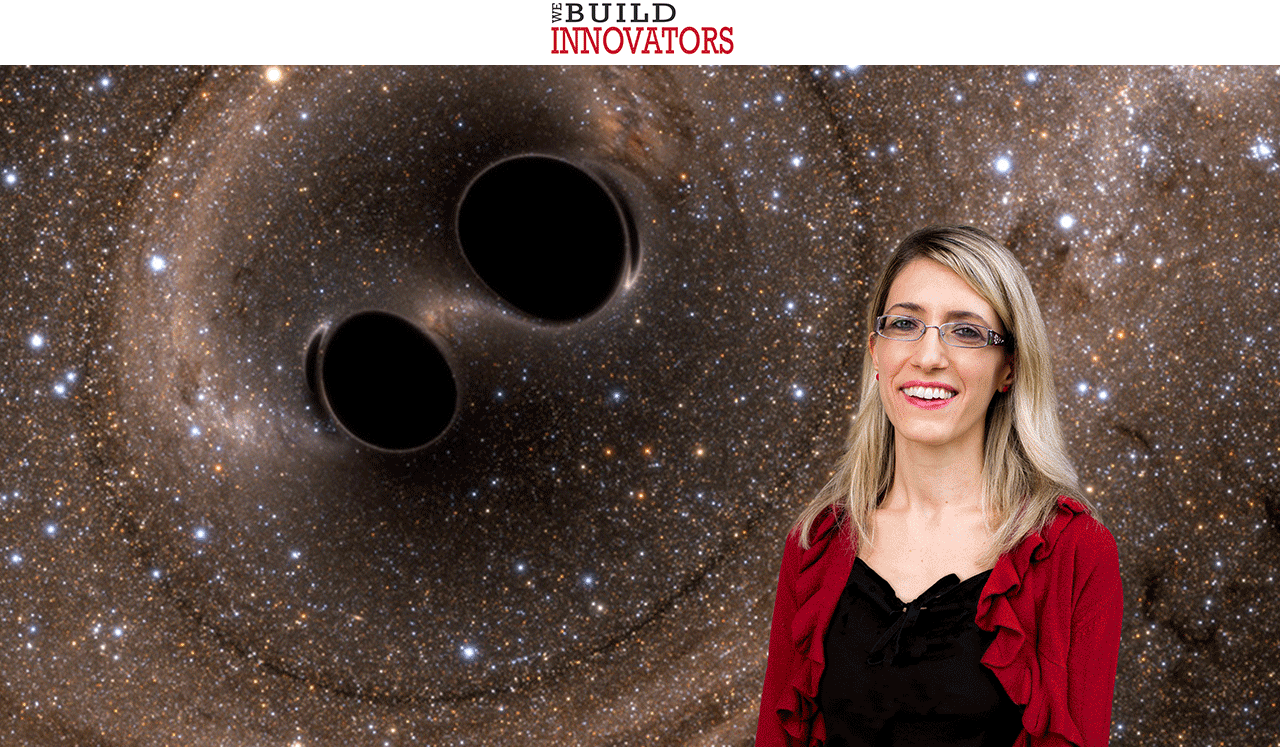Innovative Research

Texas Tech University astrophysicist Alessandra Corsi, with an artist's rendering of two black holes merging. Corsi was on a research team that confirmed gravitational waves are produced when black holes merge.
Alessandra Corsi Named One of Top 10 Scientists to Watch
TTU Astrophysicist Is A Pioneer of Multi-Messenger Astronomy.
9.30.2020 | Glenys Young
You could say Alessandra Corsi's rise to the top of her field has been meteoric, but in her case, the comparison falls short. After all, meteors burn brightly for only a short time as they disintegrate. A more apt analogy for this astrophysicist would be a shining star.
Corsi, the President's Excellence in Research Professor in Texas Tech University's Department of Physics & Astronomy, has been named to Science News magazine's sixth annual SN 10: Scientists to Watch. The list of 10 early- and mid-career scientists age 40 and under—all of whom are nominated by a Nobel laureate, a recently elected member of the National Academy of Sciences or an SN 10 alumnus—will be featured in the Oct. 10 issue of Science News. Honorees are chosen by the Science News staff for the potential to shape the science of the future.
"I am delighted and extremely honored to be included among this year's SN 10 researchers," Corsi said. "Working in the field of multi-messenger astronomy has been a wonderful, truly astronomical venture. I would not have achieved this result without the support of my family, the many colleagues I work with, and without the motivation that my students give me every day. I am grateful to all of them."
What makes Corsi one of the top 10 young scientists to watch? Her innovative approach.
Five years ago, a 1,000-member team of international scientists observed gravitational waves for the first time, confirming a century-old prediction by Albert Einstein himself. As a member of the LIGO team—that is, the Laser Interferometer Gravitational-wave Observatory (LIGO) Scientific Collaboration—Corsi was part of the discovery that won its leaders the 2017 Nobel Prize in Physics. But the work wasn't finished.
Just weeks later, LIGO scientists announced a new breakthrough. Examining a gravitational wave-causing star merger in additional ways, using ultraviolet, visible and infrared light and radio waves, presented a new opportunity to learn about cosmic events using multiple information sources. This emerging field is known as multi-messenger astronomy, and Corsi has become one of its pioneers.
As a result of her work, in January, she was honored with the 2020 Edith and Peter O'Donnell Award in Science from The Academy of Medicine, Engineering and Science of Texas. Along the way, she also was named a Fellow of the American Physical Society and has been working to establish Texas Tech as the U.S. mainland's first hub for the National Radio Astronomy Observatory's NINE program, NINE standing for National and International Non-Traditional Exchange Program.
"Dr. Corsi's selection as one of Science News magazine's 2020 SN 10: Scientists to Watch is a tremendous honor that once again proves she is a world-class astrophysicist," said Sung-Won Lee, professor and chair of physics and astronomy. "She is an outstanding scientist and educator who brings international recognition to Texas Tech. Years of her brilliant work in astrophysics led Science News to select her on this prestigious list. I sincerely congratulate her on behalf of the Department of Physics & Astronomy."
About Science News
For almost a century, Science News journalists have covered advances in science, medicine and technology for the general public, including the 1925 Scopes "monkey" trial, the advent of the atomic age in 1945, the space race and the revolution of genetic engineering from the discovery of DNA to today's gene-editing technology. It was founded as an independent nonprofit in 1921 by newspaper magnate E.W. Scripps and zoologist W.E. Ritter, who wanted to improve the quality and accuracy of science journalism. It remains true to that mission today.
College of Arts & Sciences
-
Address
Texas Tech University, Box 41034, Lubbock, TX 79409-1034 -
Phone
806.742.3831 -
Email
arts-and-sciences@ttu.edu
